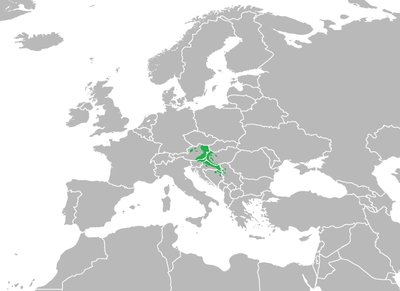Austman
| Austman | |
|---|---|
| دیچ Dîç | |
 | |
| Pronunciation | [/diːt͡ʃ/] |
| Created by | Karous |
| Native speakers | 2,916,000 (2000) |
Standard form | Viennese Language
|
Austman (دیچ [diːt͡ʃ] Dîç) is a West Germanic language belonging to the Upper German group, spoken in the southeast of the Republic of Austria down through the Pannonian Basin following the path of the Danube River through southeast Europe into Hungary and northern Bosnia and Herzegovina.
Since the independence of Austria from the Ottoman Empire in 1881, Austman has been largely rendered under the shadow of Standard German, and until 1922, did not hold any official status in the country. However, unlike other so-called "High German dialects", Austman has maintained a strong speaker base inspite of the social ubiquity of Standard German, remaining the primary language of eastern cities like Graz. This is primarily due to the massive level of divergence coupled with social separation of the Austmans due to their adherence to Islam as opposed to the majority Catholic religion of the Austrian Germans.
External History
Austman belongs to an alternate history timeline where the Austrian and Hungarian Kingdoms were conquered by and integrated into the Ottoman Empire. The languge is descended from a hypothetical Austro-Bavarian dialect spoken in Eastern Austria, with a significant input from Turkish, Arabic, and Persian superstrata, as well as lesser input from South Slavic and Hungarian constrata. Austman's intended goal is to attempt to create a language for an Islamic German culture that could reasonably have formed.
General Information
Classification
Austman is classified as belonging to the High German dialect continuum, falling squarely within the upper High German dialects, specifically the Austro-Bavarian group. Despite eventually becoming the main variation of the German language to be spoken within Vienna, the dialect did not, in fact, originate around Vienna, but rather around the south of the country. The spread of Austman and subsequent breaking into various dialects has resulted in a disruption of the original High German dialect continuum in Austria and beyond, leading to some uncertainty as to where exactly in Austria the dialect originated, though it is strongly suggested that it formed in Styria due to its strength around the city of Graz, and northward progression throughout history.
Characteristics
Austman displays a large number of loanwords from Turkish, Arabic and Persian. The number is quite larger than other languages of Christian or formerly Christian subjects of the Ottoman Empire. This is hypothesised to be due to the rapid rise in social status of the Islamized Germans that came to comprise the foundational stock of the Austmans leading to increased contact with Turkish speaking officials and administrator, as well as the extremely strong religious divide between the Austmans and Germans prevoking an intentional "islamification" of the language.
The core of the language is Germanic, comprising approximately 50% of the total base vocabulary. Words of Arabic and Turko-Arabic origins make up an additional 30% of vocabulary, mostly found in words related to topics of Religion, Law, Government and Education. Turkish loanwords add up to 10% of the lexicon, being mostly used in military, religious, and administrative terms. 5% of words, primarily related to some agricultural and labor terms, are derived from a South Slavic stock, mostly from Slovene and Serbo-Croatian origin. A percentage of Turkish loanwords are actually Persian loanwords, mostly related to fields such as medicine and science.
Phonology
History
Austman is mildly divergent in terms of its sound changes from the High German dialects that would develop into Standard German.
Austman shows a slight collapse of High German's vowel inventory by way of unrounding of /y/ and /ø/ into /i/ and /e/. As well, stressed High German /e/ broke into /ie/, later /je/ which palatized proceeding consonants.
| OHG Dipthong | Austman Result |
|---|---|
| ie | î /i:/ |
| ei | oa /ɔ:/ |
| io | î /i:/ |
| iu | î /i:/ |
| ou | ô /o:/ |
| uo | û /u:/ |
Consonants
| Bilabial | Labio-Dental | Alveolar | Post-Alveolar | Palatal | Velar | Uvular | Glottal | ||
|---|---|---|---|---|---|---|---|---|---|
| Nasal | m | n | |||||||
| Stop | b p | t d | t d | k g | |||||
| Fricative | f v | s z | ʃ | ç | x | ʁ | h | ||
| Affricate | p̪f | t͡s | t͡ʃ | k͡x | |||||
| Lateral Approximate | l | ||||||||
| Approximate | j |
Vowels
| Front | Near-Front | Central | Back | |
|---|---|---|---|---|
| Close | i | u | ||
| Near-Close | ɪ | |||
| Close-Mid | e | o | ||
| Mid | ə | |||
| Open-Mid | ɛ | ɔ | ||
| Open | a |